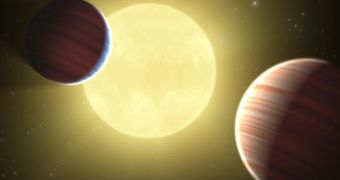Astronomers have found little under 500 planets orbiting distant stars, but confirming the milestone alien world might prove not as easy as you would think, even if some astronomers expect its official discovery by January 2011.
Last data coming from NASA revealed that astronomers confirmed 494 planets around alien suns, and there are hundreds more, waiting to be confirmed as actual worlds or as false alarms.
To do that, astronomers rely on their telescopes and space observatories, to which they add a few tricks that should help identify and confirm planets beyond our solar system.
There are four main techniques of finding exoplanets, and none is 100% flawless, SPACE.com reports.
The first one is the radial velocity method, which looks for repeated wobbles in a star's movements, because they are signs of a planet's gravitational pull moving it back and forth.
The only problem is that if a planet has very little mass, the pull it exerts isn't very high, so when an astronomer tries to detect an Earth-size planet, the noise within the data can be mistaken for a planet.
The second method is the transit method, which has astronomers looking for dips in a star's brightness whenever a planet crosses in front of it, but if this star has the same orbit as another one, the cause of regular dips might not be a planet at all.
The microlensing method is another technique, which looks for distortions in light resulting from the pull of gravity.
Still this happens only when a star with a planet lines up with another star, and this is very rare and can only occur once, according to astronomer Geoffrey Marcy at the University of California at Berkeley.
The fourth method, he explains, is when astronomers directly image the light from an exoplanet, but the you might confuse a planet with a faint star, because “faint stars look a lot like glowing planets”.
Another interesting thing is that until today, there is no explicit list of the criteria an exoplanet should meet, established by the International Astronomical Union, which assigns official designations to celestial bodies.
There are only unofficial lists like those of astrobiologist Jean Schneider at the Paris-Meudon Observatory and astronomer Jason Wright of the University of California in Berkeley, and basically, each researcher decides whether or not a candidate should be declared an exoplanet.
What they usually do, is they wait until the probability that their results are false alarms falls below 1%, and then if their report is published in a scientific journal, this means that it is accepted.
Schneider said that sometimes, even after publication, there are a few exoplanets that have been retracted as false alarms — “5 to 10 since 1989,” he estimates.
Marcy explained that “there's always a chance there's a few errors in data to make something look like a planet.
"This can happen to anyone — just one of those things that happens when you're pushing a frontier, pushing instruments to their bitter limits.
“This kind of astronomy is hard work, and there are lots of ways to make a mistake; a number might slip through, but they're generally corrected in a year or two.”
Astrobiologist Alan Boss at Carnegie Institution of Washington said that “the real acid test in the field is getting two methods to detect an object — for instance, a radial velocity signature plus a transit detection.
“There are about 100 of such absolutely, positively identified planets so far.”
Boss added that in the end, “there is no real honor roll of planets, no real way to say which the 500th planet will be.”
But as in the past 15 years there have been nearly 500 planets discovered, things should accelerate in the future.
NASA's Kepler mission, a space observatory surveying a large sample of stars as it orbits the sun, detects far more possible exoplanets than astronomers can confirm.
Many of them are now being verified with radial velocity confirmations, and “on Feb. 1, we'll announce all of them — a huge avalanche of exoplanet candidates," Marcy added.

 14 DAY TRIAL //
14 DAY TRIAL //